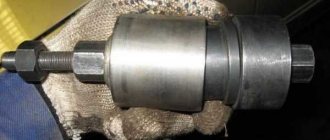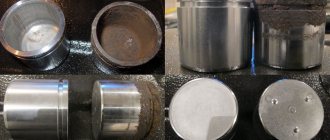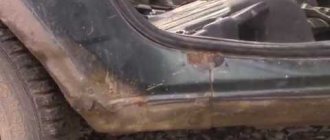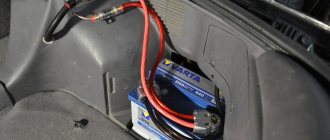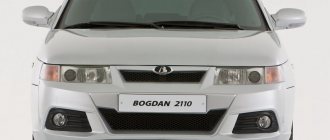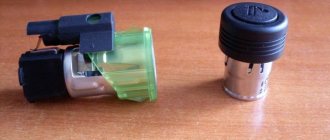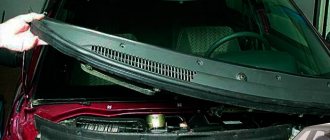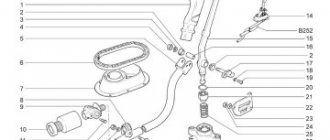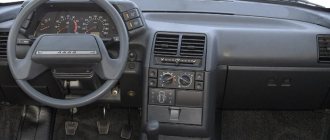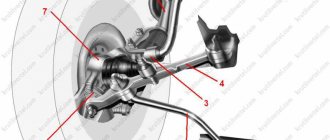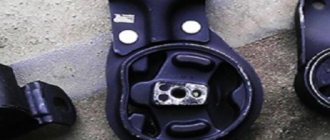When choosing wheels for a VAZ, you need to look not only at their appearance, but also at the possibility of using them on a particular model. In addition, certain technical characteristics must be taken into account.
The most important of them are:
- bolt pattern;
- diameter;
- departure;
- fastening elements;
- diameter of the centering hole.
What tire sizes does the manufacturer recommend to install?
The standard size depends on the body type. Moreover, all cars without exception used discs with a hub diameter of 58.5 mm. The amount of overhang could fluctuate - within 37-40 mm. The rim width is also typical - 5-5.5J. The most common model is 2110. This digital combination is used to mark a car with a sedan body.
The manufacturer recommends the following sizes:
- 2110, 21101, 21102 – 175/70 R13;
- 21103, 21104 – 175/65 R14.
"Razboltovka" - 4x98 mm. A special modification is the VAZ 21108 Premier car. The car was produced for a relatively short time - from 1999 to 2001. The only difference from previous versions is that alloy wheels with a diameter of 13 inches were installed at the factory. There are no fundamental differences for station wagon cars.
The issue was carried out between 1997 and 2004. The wheels installed at the factory differed depending on the modification of the car and the marking of the specific model:
- 2111 – 175/70 R15;
- 2111i-2114 – 175/65 R14.
Hatchbacks were produced, like most other cars in this series, until 2004. The diameter of the wheels and their dimensions also differed slightly depending on various factors:
- 2112 – 175/65 R14;
- 21122 – 175/70 R13;
- 21124 – 175/65 R14.
Using tires of standard size and diameter will avoid damage to the body and other troubles. However, the automaker suggests the possibility of installing custom-sized wheels.
Selection by car model, tire or wheel size
By car By tire size By wheel size
The highlighted entries mean factory sizes, the rest are replacement options
Modifications
1.5i 16V 1.6i 1.6i 16V 1.8i
VAZ 2112 2007 1.5i 16V
Generation: 2112x Power: 93 hp | 69 kW | 94 PS Engine: I4, petrol Central hole diameter: 58.6 mm Thread: M12 x 1.25 Fastening type: bolt Years of manufacture:
| Tire | Disk | Sverlovka | Pressure |
| 175/65R14 | 5.5Jx14ET35 | 4×98 | 2 (29) |
| 185/60R14 | 5.5Jx14ET35 | 4×98 | 2 (29) |
| 175/65R14 | 6Jx14 ET35 | 4×98 | 2 (29) |
| 185/60R14 | 6Jx14 ET35 | 4×98 | 2 (29) |
VAZ 2112 2007 1.6i
Generation: 2112x Power: 80 hp | 60 kW | 82 PS Engine: I4, petrol Central hole diameter: 58.6 mm Thread: M12 x 1.25 Fastening type: bolt Years of manufacture:
| Tire | Disk | Sverlovka | Pressure |
| 175/70R13 | 5.5Jx13 ET35 | 4×98 | 1.9 (28) |
| 175/65R14 | 5Jx14ET35 | 4×98 | 2 (29) |
| 175/65R14 | 5.5Jx14ET35 | 4×98 | 2 (29) |
| 185/60R14 | 5.5Jx14ET35 | 4×98 | 2 (29) |
| 175/65R14 | 6Jx14 ET35 | 4×98 | 2 (29) |
| 185/60R14 | 6Jx14 ET35 | 4×98 | 2 (29) |
VAZ 2112 2007 1.6i 16V
Generation: 2112x Power: 89 hp | 66 kW | 90 PS Engine: I4, petrol Central hole diameter: 58.6 mm Thread: M12 x 1.25 Fastening type: bolt Years of manufacture:
| Tire | Disk | Sverlovka | Pressure |
| 175/65R14 | 5.5Jx14ET35 | 4×98 | 2 (29) |
| 185/60R14 | 5.5Jx14ET35 | 4×98 | 2 (29) |
| 175/65R14 | 6Jx14 ET35 | 4×98 | 2 (29) |
| 185/60R14 | 6Jx14 ET35 | 4×98 | 2 (29) |
VAZ 2112 2007 1.8i
Generation: 2112x Power: 97 hp | 72 kW | 98 PS Engine: I4, petrol Central hole diameter: 58.6 mm Thread: M12 x 1.25 Fastening type: bolt Years of manufacture:
| Tire | Disk | Sverlovka | Pressure |
| 175/65R14 | 5.5Jx14ET35 | 4×98 | 2 (29) |
| 185/60R14 | 5.5Jx14ET35 | 4×98 | 2 (29) |
| 175/65R14 | 6Jx14 ET35 | 4×98 | 2 (29) |
| 185/60R14 | 6Jx14 ET35 | 4×98 | 2 (29) |
Sizes of wheels, tires and disks of VAZ 2112 of other years of production
1999 2000 2001 2002 2003 2004 2005 2006 2007 2008 2009
This is interesting: How to drive on winter tires
What non-standard sizes can be supplied?
Installing wheels with a diameter or width larger than the standard size may cause a malfunction. Before purchasing, you must ensure that the installation is safe. A good solution is a preliminary “trying on”. You should install the wheels before purchasing. It is especially important to check the front tires: they should not touch the fender liners or the car body.
Often, too high a tread height leads to contact with the fender liners. This can have serious consequences:
- damage to the plastic of the wheel arches;
- mudguards become damaged and cease to perform their function;
- Cavities and rust appear at the points of contact between the tread and the paintwork.
The latter is especially dangerous. Since unprotected metal rots quickly, literally within 1 winter. AvtoVAZ cars have never been famous for their high-quality anti-corrosion treatment. Also, increasing the weight of the wheel by literally a few kilograms will lead to accelerated wear:
- wheel bearings;
- shock absorber struts and other suspension elements.
The manufacturer allows the installation of the following non-standard tire diameters on VAZ 2110 vehicles and modifications:
The diameter of R14 is typical and relatively small. It is allowed to use tires with a tread width of up to 185 mm and a height of up to 75-80. Tires with a diameter of 15 inches are also usually installed on this car without any problems. R16 is a tire that requires some driving skill. Since this diameter is not standard, the machine is not designed for this weight and size.
R17 and R18 can only be installed after some modification using a special roller - the wheel arches simply “roll out”. This will avoid contact between tires and body parts. Also, constant friction of the tread on the fender liners will cause the pattern to quickly wear off and lead to deterioration of the wheel’s grip on the road.
VAZ 2115
The factory is equipped with two standard sizes: R13, R14. Dealership centers that sell tires for imported cars offer tires that fit the VAZ 2115:
- 175/70 R13 82T.H,
- 175/65 R14 82T.H,
- 185/60 R14 82T.H.
Accordingly, it requires installation of disks:
- 0JR13 H2, PCD: 498, ET35,
- 5JR13 H2, PCD:498, ET35-40,
- 0-5.5-6.0JR14 H2, PCD:498, ET35-40.
The diameter of the mounting hole must be at least 58.6 mm.
What is the tire pressure
It is important to constantly monitor the tire pressure - this will avoid difficulties when operating the car.
It should be noted that for different tire sizes the value may differ slightly:
- 175/70 R13: for front wheels – 1.9 MPa, for rear wheels – 1.9 MPa;
- 175/65 R14: for front wheels – 2.0 MPa, for rear wheels – 2.0 MPa;
- 185/65 R14: for front wheels – 2.0 MPa, for rear wheels – 2.0 MPa.
Some drivers deliberately inflate the front wheels below the manufacturer's specified value. Main reasons:
- less load is placed on the suspension;
- minimal feedback to the steering wheel when hitting bumps or other road irregularities.
However, low blood pressure causes:
- deterioration of management;
- quick “grinding” of the tread along the edges of the tire;
- increased gasoline consumption - by 10-15%;
- uneven axle load.
Excessively high blood pressure also causes problems. For example, when heated to 60 degrees Celsius or higher, the wheel may simply burst.
If a wheel is damaged, you must stop immediately in a safe place. Stopping your vehicle to change a tire on a busy road or on the side of a busy road can be dangerous. If a wheel is damaged, turn on the hazard warning lights and move slowly and carefully along the side of the road or along the far right lane until the nearest exit to a suitable area sufficiently distant from the roadway.
1. Place the car on a flat horizontal platform with a hard, non-slip surface at a sufficient distance from the roadway. Move the gear shift lever to reverse position. Apply the parking brake. If you are towing a trailer, it should be disconnected.
2. Ask passengers to get out of the car and move away from the roadway.
3. Place a jack under the car in a specially designated place next to the damaged wheel. If the car is parked on soft ground, place a wide and fairly solid support (for example, a board) under the lower support of the jack.
Note The jack must be installed only in specially designated points on the body (indicated in the figure), otherwise the body may be deformed or the vehicle may not be secured securely.
WARNING Make sure the jack is stable, otherwise the vehicle may fall off and cause personal injury. It is strictly forbidden to stand under a vehicle that is raised by a jack alone or to place your hands or feet under it.
4. Under the wheel located diagonally from the damaged one, it is necessary to place wheel chocks on both sides or, if there are no chocks, stones large enough to prevent the vehicle from moving.
5. Using a wheel wrench, loosen the wheel bolts by half a turn.
6. Using a jack, raise the car to a height sufficient to remove the wheel, and completely unscrew the wheel bolts, then remove the damaged wheel from the car. Please note that wheel bolts can be heated to high temperatures. Temporarily place the removed wheel on a platform near the car with the outer side facing up.
7. Before installing the spare wheel, thoroughly clean the adjacent surfaces of the wheel disk and hub from dirt using a clean rag.
WARNING Use caution.
As a result of braking, the parts being wiped could heat up to a high temperature.
8. Install the spare tire. Tighten the wheel bolts by hand. Then tighten the bolts using a wheel wrench. Tighten the bolts in several approaches in a crisscross pattern. The wheel should be pressed tightly and evenly against the hub flange. Do not fully tighten the wheel bolts on a suspended wheel.
9. Lower the car and remove the jack.
10. Fully tighten the wheel bolts in a cross pattern. It is not recommended to tighten the wheel bolts by pressing the key handle with your foot, as this may cause the key to break off and damage the wheel rim or cause injury.
11. Place the damaged wheel, tools and jack in the trunk.
Note It is recommended to check the tire pressure of the installed wheel at the first opportunity and, if necessary, adjust it.
Review of the best summer and winter tires
It is better to acquire separate sets of summer and winter tires in advance. Pirelli Cinturato P1 Verde tires are ideal for the warm season. Their cost is relatively high (from 3,500 rubles per 1 tire). However, they perform excellently on wet asphalt and are highly resistant to wear.
- Continental Conti Premium Contact 5 is well balanced. There are a large number of special drainage channels - they make it easy to drain water from the contact patch. This kit will cost slightly less than the one discussed above.
- Goodyear EfficientGrip Performance provides good grip and low fuel consumption. However, the tread thins out quite quickly - especially during intense driving. The rubber is soft and handles well. Despite its softness, it is difficult to damage it redder.
- Dunlop Sport BluResponse is relatively cheap compared to all the options discussed above. However, it has its weaknesses. For example, on wet asphalt the wheels slip a lot and handling deteriorates.
Tires, wheels for Lada (VAZ) 2110 (LADA (VAZ) 2110)
LADA 2110 is a series of cars that were produced from 1995 to 2009 at the VAZ automobile plant. The most popular car of the family is the VAZ 2110. Experimental models were produced in 1995, and mass production started in 1996.
What sizes of tires and wheels for the Lada (VAZ) 2110 does KOLOBOX recommend?
In order to determine which tires and rims are suitable for this vehicle, it is necessary to determine the optimal sizes with which the car is produced, as well as alternative options.
The table below shows tire parameters (on the left) and wheel characteristics (on the right). At KOLOBOX, every Lada-2110 driver will be able to receive detailed advice and select summer and winter tires, cast or stamped wheels.
| Front axle and rear axle | Front axle and rear axle | ||||||
| R13 | R13 | ||||||
| Orig | 175/70R13 | winter | summer | Orig | 5×13 4*98 d58.5-58.6 ET40 | casting | stamp. |
| Replacements | 185/65R13 | winter | summer | Replacements | 5-5.5×13 4*98 d58.5-100 ET20-39 | casting | stamp. |
| R14 | R14 | ||||||
| Orig | 175/65R14 | winter | summer | Orig | 5.5×14 4*98 d58.5-58.6 ET35 | casting | stamp. |
| Orig | 185/60R14 | winter | summer | Replacements | 5-6×14 4*98 d58.5-100 ET20-39 | casting | stamp. |
| R15 | R15 | ||||||
| Replacements | 195/50R15 | winter | summer | Replacements | 6-7.5×15 4*98 d58.5-100 ET20-39 | casting | stamp. |
| Replacements | 185/55R15 | winter | summer | ||||
2110 is equipped with wheels with diameters of 13 and 14 inches. The width of tires varies from 175 to 185 mm, and the profile from 70 to 55%. Thus, the main sizes are: 175/70 R13, 175/65 R14, 185/60 R14. And alternatives: 185/65 R13, 195/50 R15 and 185/55 R15.
We select winter tires for the LADA (VAZ) 2110 car
Summer tires differ from winter tires in their special structure, which begins to harden when the temperature drops to a certain level. This leads to a significant deterioration in adhesion to the road surface, which in turn reduces safety and comfort while driving. Therefore, it is necessary to promptly apply for replacement sets of tires.
Several models of tires for winter:
| Winter tires for Lada (VAZ) 2110 | Kumho KW7400 Maxxis NP3 Arctic Trekker Kama Kama-505 Irbis Contyre Arctic Ice Kama Kama-519 Euro Cordiant Winter Drive |
We select summer tires for the Lada (VAZ) 2110 car
Many owners of Lada 2110 cars turn their attention to low-profile tires. Before you decide to install them on your car, it’s worth knowing their pros and cons. The positive aspects of low profile tires include:
- Increased maneuverability while driving.
- Increased controllability: the wheels react quickly and “sharply” to any steering movements.
Installation of R16 on VAZ 2110, 2111, 2112
1:502
Race Ready CSS155 wheels were purchased with the following parameters: R16 7J ET35 4×98/4×100 (R16 – disk diameter; 7J – disk width; ET35 – disk offset; 4×98/4×100 – bolt pattern). And also summer tires with parameters 205/45/R16.
1:826
2:1331
3:1836
When I was looking for information about installing R16 on a VAZ 2110-2112, I found practically nothing worthwhile, only 1-2 entries where everything was described in detail.
3:2098
Why did you choose 7J wide wheels and not 6.5J or 6J? Initially, I couldn’t decide which tires to take: 205/45/R16 or 195/45/R16. When purchasing tires with parameters 195/45/R16, these tires will fit smoothly on wheels with a width of 6.5J, and on wheels with a width of 7J with a small house. And when you buy tires with parameters 205/45/R16, these tires will fit on wheels with a width of 6.5J “donut” - with the rubber protruding outward (which I categorically did not want) and on wheels with a width of 7J, tires with these parameters will fit smoothly, without a house and without convexity outward. Therefore, I chose 7J wide wheels, which gives me the opportunity to install both 195/45/R16 and 205/45/R16 tires without losing their appearance.
3:1157
Now I want to provide my comparison of tires with parameters 205/45/R16 and with parameters 195/45/R16:
3:1326
1. Rubber with parameters 195/45 is lower than 205/45, therefore, tires with parameters 195/45 will look better, but the ride will be harsher due to the lower profile and due to higher tire pressure, and tires with parameters 205/ 45 will look a little worse (slightly) due to the larger profile, but the ride will be correspondingly more comfortable.
3:1922
2. Tires with parameters 205/45 are wider than 195/45, therefore, on tires with parameters 205/45 it will be more comfortable due to the width, but it will be harder to turn the steering wheel, also due to the width, and on tires with parameters 195/45 everything will be fine, accordingly, on the contrary: the ride is a little stiffer, the steering wheel is easier to turn.
3:2414
3. Rubber with parameters 195/45 is lighter than rubber with parameters 205/45, therefore, with tires 195/45 there is less load on the wheel bearings, less loss in dynamics, less consumption, but the rubber itself plays a big role here, not the parameters, t Because depending on the company, even tires with parameters 205/45 can be lighter than rubber with parameters 195/45.
3:601
4. Tires with parameters 195/45 on wheels with a width of 7J will fit a little like a house, in contrast to tires with parameters 205/45, which will fit flush. Consequently, tires with parameters 195/45, which will stand up a little like a house, will look better, but there is a greater chance of damaging the disc if it gets into a hole, and with tires 205/45 this probability is less.
3:1211
5. It is easier to install tires with parameters 195/45 on a VAZ than 205/45. Fewer or no modifications will be required (depending on suspension configuration).
3:1509
6. With 205/45 tires, the car will be higher than with 195/45 tires, but not significantly. So, if compared with standard wheels 185/60/R14, then a wheel with 195/45 tires will be larger in diameter by 4 mm, i.e. the car will become higher by approximately 2 mm (depending on the company and the condition of the tires), and the wheel with 205/45 tires it will be 12 mm larger in diameter than a standard wheel, i.e. the car will become approximately 6 mm higher (also, a lot depends on the company and the condition of the tires). According to my measurements, after switching from 185/60/R14 wheels to 205/45/R16 wheels (tires in both are used, the balance is 80%), the car became higher by approximately 6-9 mm.
3:2566
The choice fell on tires with parameters 205/45/R16, because for now there is only one car, and our roads are simply terrible, driving on them is a real challenge. If I only drove around the city, I would take tires with parameters 195/45/R16, because in the city it’s still tolerable. But based on the fact that the car is still used for everyday use and for driving on the highway, it would be more reasonable to start with higher tires (i.e. 205/45). But I always have the opportunity to install 195/45 tires, as I wrote about above.
3:805
Next I will write about the problems that I had when installing sixteenth wheels on 205/45/R16 tires. At the same time, it would be appropriate to point out those elements of my suspension that may affect the installation of sixteenth disks. This:
3:1218
— Bilstein gas-oil shock absorbers with standard rod length; — fenders SS-20 (standard length) 2110; — “Technospring” springs with a lowering of 30 mm; — castor (stand angle) 0.30 (planned to increase to 1.30); — front wheel camber 0.30 (factory); — negative camber of the rear wheels 1 degree.
3:1762
Now let's return to the problems that arose immediately after installation. At the same time, I will describe the problems associated with the width of the 7J wheels and the tire parameters 205/45. Installing other tires or other wheels is not considered as a solution to problems, since this post is a mini-tutorial for those who will install wheels with the same parameters as I chose. Okay, enough digressions, let's move on to the problems:
3:2514
1. On bumps and turns, the rear wheels rustled against the flanging of the rear arches, while the wheel on the side of the gas tank neck rustled more, which is associated with the displacement of the beam. It is treated by cutting half or 2/3 of the edge of the arch.
3:410
2. When banking on corners at low speed, the rear wheel, the one on the driver’s side, rustled a little against the spring cup, although in a standing position the distance from the wheel to the spring cup was 5-8 mm. Most likely, this is also due to the displacement of the beam towards the other wheel, and to tired silent blocks of the rear beam. It can be treated by filing the spring cup, or raising it higher (I have the opportunity to move the spring cup 1 cm up on the Bilstein rear shock absorbers, but I didn’t do this), as well as by replacing the silent blocks of the rear beam. Personally, I haven’t changed the silent blocks yet, but for now I just cut the sound insulator of the spring cup and sharpened the spring cup a little, and the shuffling almost stopped.
3:1716
3. When turning the steering wheel to its extreme positions, the steering wheel does not turn completely, and the wheels rustle against the side members, while the wheel on the driver’s side rustles less. Treated with spacers. I installed 6mm spacers. As a result, the front wheel on the driver’s side has stopped shuffling, and the front wheel on the passenger side is shuffling, but the steering wheel is already turned almost all the way. With the above wheel width, disc offset and 6 mm spacers, the wheels sit in the arches and do not throw up the body. I would also like to note that the view has become much better than with factory-sized wheels recessed inside.
3:2841
4. Also, during intensive braking (within reason) from speed, the wheels shifted slightly towards the doors and, accordingly, rustled against the sills, arch linings and factory fender liners. This problem can be treated by increasing the castor and replacing the silent blocks of the cross member (hinges of the lower control arms). How I dealt with this problem, I wrote in a previous blog post. But if your castor is normal (at least 0.30 degrees) and the silent blocks are not worn out, then this problem most likely will not arise.
3:889
As for the pros and cons of installing sixteenth wheels with 205/45 tires, most have an idea about this, even without installation.
3:1147
Cons: 1) faster wear of suspension elements on our “roads”; 2) driving over uneven surfaces becomes harsher, hence the loss in comfort; 3) it’s harder to turn the steering wheel (I almost didn’t notice); 4) increase in consumption, loss in dynamics (virtually not noticed); 5) more expensive tires than on factory wheels; 6) great care is required on the road so as not to damage the tires and wheels; 7) some work is required for installation; faster pad wear. Pros: 1) controllability; 2) appearance, which more than covers all the disadvantages))
3:2140
Now I’ll point out my personal feelings after installing sixteenth wheels on 205/45 tires:
3:165
1. It became tougher, but not much, I thought it would be tougher. Just right for driving around the city and on a good highway. On some bumps it has become even softer, because the wheel has increased in diameter, and over some small bumps, joints, cracks, into which I had previously fallen with a wheel of a smaller diameter, I now drive more softly, rolling over the bump and not falling into it;
3:816
2. Surprisingly, no matter how much I drive, the consumption has practically not increased (maybe only in the city), despite the fact that the previous 14 wheels weighed approximately 13 kg, and the new sixteenth wheels weighed approximately 16 kg (disc - 7.8 kg, tires 7.9-8 kg). There is no BC yet, so I calculated the consumption myself, the driving mode is mixed. Highway consumption: 5.5–7 liters per 100 km. City consumption: 8-9.5 liters per 100 km.
3:1456
3. Due to the low profile and width of the tires, handling has become much better, especially in turns, and also when you sharply steer around potholes.
3:1728
4. The view, of course, has changed significantly for the better. I agree with Henry Ford’s statement “80% of the beauty of a car is in its wheels.” Of course, I could write here for a long time about how much I admired the new appearance, but I think that would be unnecessary.
3:2176
5. Also, I was very surprised that the steering wheel practically did not turn harder, which I was afraid of, at 205 width.
3:191
6. The dynamics, in principle, practically remained at the same level, maybe they got a little worse (I don’t understand yet).
3:377
7. Now, in my opinion, when braking, you have to put more force on the brake pedal, but in my driving mode, with 14 ventilated discs, there are enough brakes, but if there are 13 non-ventilated discs, then, in my opinion, The brakes need to be improved.
3:845
8. When braking sharply, the car stops rooted to the spot and practically does not skid even on wet asphalt, but, of course, a lot depends on the road surface, weather conditions and speed. I have not used it in extreme conditions yet.
3:1275
9. With sharp acceleration, the axle box almost disappeared. Even if it exists, it is not as long as on factory wheels.
3:1500
As for tire inflation, I was guided by this table. The front is 2.4, the rear is 2.3, because the rear is lighter.
3:1692
4:2197
I wanted to switch to studs first, but then decided to stick with bolts for now. Installing discs on bolts, in principle, does not cause me any inconvenience, and I don’t remove wheels very often. If there are centering rings, then no problems arise. By the way, the bolts and sockets for these discs need different ones (ordinary ones won’t work), for narrow holes.
4:618
Why do I write so much and in detail? As I already wrote at the beginning, before purchasing and installing, I found very little detailed and useful information on this matter, and therefore I decided on my own, to help those who are going to install sixteenth wheels on a VAZ, and in particular on 2110-2112.
4:1107
I think this is where I will end this long and tedious, but useful for some, post. If I have not indicated something essential, or if you have questions, please write. I will also repeat that those who think that this idea of installing sixteenth wheels on a VAZ is pointless, then pass by, because I understand that for some, a car is just a means of transportation, where everything that costs is better and more durable from the factory (with which I practically agree, but not in everything), but for some it’s something more. Personally, I will later buy a car from a foreign manufacturer for everyday driving, where there will be no major modifications, and the 2112 will be left for cruising and for building a turbo engine.
4:2286
And, of course, a photo of a car on sixteenth wheels, and a photo of the wheels separately. In addition, new thresholds have already been purchased and are awaiting installation, with which the view will be even cooler)
4:299
5:804
6:1309
7:1814
8:2319
Save to Album
8:37
https://www.drive2.ru/l/3589707/
8:73 next article:
Illuminated car logo VAZ 2110, 2111, 2112
With the advent of LEDs, a second wind opened for car tuning. For example, using the same LEDs
9:916
Rating 1.00 [1 Vote]
30712
The best all-season tires for the VAZ-2110
All-season tires are in particular demand among Russian drivers. It allows you to use one set for a long time, without wasting time on off-season “change of shoes.”
The performance properties of the rubber compound enable these tires to function normally in the summer and winter seasons.
Kama-365 (NK-241)
Description of the tire. The model is characterized by large tread blocks located diagonally, as well as deep recesses designed to drain snow and water.
Powerful shoulder blocks reliably hold the car on wet or muddy roads. The wide slots of the grooves separating them contribute to good maneuverability on dirt roads or snowy sections of the road.
The robust design of the model, made of high-quality steel, as well as the seamless production technology of a synthetic breaker, makes the tire resistant to deformation.
Two central powerful stiffening ribs allow the driver to maintain directional stability in various driving modes.
The rounded transition from the tread to the side allows the rubber to instantly respond to steering inputs and improves control.
- Low noise level.
- Reasonable price.
- Predictable control.
- Elastic tire at slightly sub-zero temperatures.
- Long service life.
VAZ 2114
Tires of two sizes are relevant for the hatchback: R13, R14. Full details can be found in the technical manual. The optimal size is considered to be R13. In summer, such models are completely safe.
R14 tires are considered more suitable for winter. Tires with dimensions 175/65 can be considered an ideal option for driving on snowy roads, as well as icy tracks.
When choosing, be sure to take into account the width of the tire. It will not allow the car to “drown” in the snow; it will only be pushed to a certain depth.
Factory wheel parameters depend on the vehicle configuration. They can be standard or slightly enlarged:
- 175/65R14,
- 175/70R13,
- 185/60R14.
For such tires, wheels on the VAZ 2114 are suitable 14.4x98. Moreover, their width is selected according to the size of the tire. Usually it is in the range of 5-6.
If R15 are installed, the wheels must be 6.0/6.5x15 4x98. For R16 tires – 6.5x16 4x98.
The best summer tires for the VAZ-2110
The summer tire segment for the VAZ-2110 is represented by budget models. However, not only the reasonable price is the advantage of these tires.
They have good performance characteristics and high strength characteristics.
Viatti Strada Asimmetrico V-130
Description of the tire. This model of summer tires allows the driver to confidently navigate flooded roads without fear of aquaplaning.
An effective drainage network, consisting of powerful longitudinal channels and capacious inclined grooves, quickly copes with the removal of water from the contact area between the wheel and the road.
The computer-simulated arrangement of the asymmetrical tread elements makes it possible to reduce noise when driving.
High-density central blocks maintain directional stability and make driving predictable.
The original shape of the slots in the edge zones allows you to hold the car when changing lanes or performing maneuvers.
- Moderate noise.
- Clear management.
- Minimal wear.
- Confident grip on wet and dry roads.
- Reliable, durable rubber.
Normal, working tires of average quality at an affordable price - the opinion of its owners about the model.
Cordiant Comfort 2
Description of the tire. The main advantages of the model are a high level of safety, good strength characteristics, and high-quality grip on any type of road surface.
The model's compound consists of two layers. The upper one, elastic and soft, reliably contacts the surface of the road, neutralizes shock when driving over holes and bumps.
The lower one is characterized by an increased density of the rubber mixture, which allows the material not to lose its shape during intensive use and in hot weather.
The tire breaker consists of steel and synthetic cord. This combination helps the rubber be puncture resistant and extends its service life.
The presence of three wide drainage channels makes it safe to travel through water sections of the road. Their volume is quite enough to drain the contact area between the tire and the highway.
- High wear resistance.
- Acoustic comfort.
- Normal control.
- Good price.
- Operational balancing.
- Low rolling resistance.
The best winter non-studded tires for the VAZ-2110
Warm winters have become a common occurrence in Russia. In the absence of roads with ice in such conditions, friction tires come to the rescue of motorists.
They reliably contact the winter road with their dense, pronounced checkers.
Belshina Artmotion Snow
Description of the tire. The symmetrical model is distinguished by a directional arrangement of contact spots on the tread, diverging from the middle stiffener rib.
The classic V-shaped layout ensures confident vehicle control on a winter highway and helps maintain speed limits.
Along the entire profile, zigzag lamellas are placed on the surface of the contact blocks. Their numerous edges cling to the road surface, providing reliable grip on the road.
Solid lugs of the edge zones ensure good maneuverability of the vehicle. Wide grooves separating them prevent movement and reduce wear.
Longitudinal channels and numerous recesses located across the entire width of the profile remove snow and water from under the wheel.
- Soft, comfortable for driving on uneven roads, rubber material.
- Good maneuverability.
- Reliable movement on slush, wet asphalt, and snow.
- High-quality braking.
- Affordable price.
- Durable material.
Viatti Brina V-521
Description of the tire. A complex tread pattern that helps to confidently “hold” the car on any type of winter road, an effective drainage system – these are the characteristic features of the model of the Russian company.
The quality of grip on the road is ensured by a mixture specially developed for the model, as well as numerous sipes.
The elastic material of the contact blocks fits tightly to the track surface, and the edges of the slots tenaciously hold the road surface.
The contact spots located on the outer zones are equipped with an additional layer, which enhances their strength and allows the vehicle to maintain stability on turns and when changing lanes.
Multidirectional arrangement of tread grooves makes it possible to reduce noise levels and improve acoustic comfort.
- High-quality compound - does not harden at low temperatures.
- Good directional stability.
- Passable tires that do not get buried in the snow.
- No slipping at the start.
- Acceptable price.
- Excellent handling.
The owners of these Velcro tires have no comments about the manufacturing company. They recommend the product for purchase.
The best winter studded tires for the VAZ-2110
Studded tires will save the driver and his car from troubles when traveling on icy roads.
The best inexpensive models of such tires from domestic manufacturers are presented in our review.
Viatti Brina Nordico V-522
Description of the tire. The model received an asymmetrical pattern, in which the central longitudinal rib is shifted closer to the inside. This arrangement improves the vehicle's directional stability and promotes stable handling.
A large number of diagonal contact blocks located in the middle blocks makes for reliable braking on roads with any surface.
The tread in this model is studded along the shoulder areas. It allows you to keep the car on a slippery highway and maintain stability when changing lanes.
The entire width of the profile is covered with lamellas of different shapes and directions. Their upper parts are equipped with hard edges, with the help of which the tire tenaciously holds the car on a slippery surface.
- Excellent cross-country ability on snow.
- High-quality braking.
- Reliable compound.
- Adequate cost.
- Confident grip on ice, slush, and wet asphalt.
- Easy balancing.
Owners of these tires believe that their price corresponds to the quality of the model. In terms of performance properties, it is not much inferior to studded winter tires from well-known brands.
Kama-Euro-519
Description of the tire. A characteristic feature of the model is the presence of a large number of studs installed on a symmetrical directional tread.
Their hard tips reliably bite into the icy crust of roads, holding the car in various modes of movement.
Nizhnekamsk manufacturers use high quality materials when producing: natural rubber, polymer additives. Such a mixture remains elastic in severe frosts and does not lose performance characteristics.
Wide recesses between the shoulder contact blocks extend far to the sides. This arrangement allows the driver to confidently get out of drifts on the road and improves cross-country ability.
The directional V-shaped arrangement of the contact patches of the central zone promotes precise control and supports movement at high speed.
- Acceptable price.
- Excellent driving performance at low outside temperatures.
- Confident behavior in a rut.
- Decent braking on snow, wet or dry asphalt, and ice crust.
- Reliable installation of spikes, they do not fall out.
- Wear resistance.
This model has good driving properties and is inexpensive, its owners note. They recommend it for purchase.

